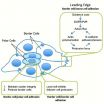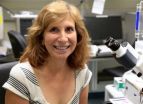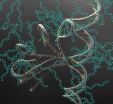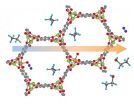(Press-News.org) What do sled dogs and cell clusters have in common? According to research by UC Santa Barbara's Denise Montell, they both travel in groups and need a leader to make sure they all follow in the same direction.
Montell, Duggan Professor of Molecular Cellular and Developmental Biology, and colleagues worked on three independent projects involving E-cadherin, a protein found in epithelial cells throughout the body. The researchers used fruit-fly ovaries to uncover the role played by E-cadherin in collective cell migration. Their findings are reported today in the journal Cell.
According to traditional scientific dogma, E-cadherin acts like the mortar between bricks, holding cells together and preventing motility. Montell's team found the opposite: Cadherin is actually promoting the ability of cells to move and migrate. "It's doing it in three different ways in three different parts of the cell," Montell said. "In each spot in the cell, cadherin is doing something different and all of those function together to orchestrate the movement of cells."
Montell's team sought to understand the E-cadherin-mediated migration of these cells with three separate approaches that converged on one idea: the guidance of cell movement. "This kind of motility is similar to what tumor cells do when they metastasize," Montell said, "and it's part of the normal development of different tissues."
One researcher studied the interaction between the lead cell and the following cells; hence, the sled-dog analogy. The lead cell is tethered by E-caderin to other cells in the cluster and pulls them in the proper direction in the same way the lead sled dog guides its team.
While E-cadherin is distributed throughout the cell cluster, the lead cell — determined by the strong force of E-cadherin that causes the cell to protrude in the direction of the movement — can communicate with the side and rear cells and prohibit them from protruding. This creates a front and back to the entire cluster of cells.
Lead author Danfeng Cai, a graduate student in the Denise Montell Lab, suppressed cadherin in different cell types and analyzed the visible guidance defects by making movies of the migrating cells. When cells lacked E-cadherin, they were unable to migrate as an organized group, and the direction of their movement was random and irregular.
Another member of the research team designed an optical sensor of mechanical tension — a kind of microscopic spring — and inserted it into the cadherin protein. This enabled the measurement of force on the E-cadherin molecules. The results showed that even though the distribution of the protein was uniform, the force per molecule was stronger at the front. "It's kind of amazing that you can make that measurement in living cells," Montell said.
In addition to highlighting E-cadherin's role in cell migration, the paper introduces new experimental tools the team used to probe and analyze E-cadherin in living tissue, the first being the optical sensor of mechanical tension. The researchers found that E-cadherin molecules implanted with the sensor were fully functional. This allowed them to generate transgenic flies containing only E-cadherin molecules with optical sensors.
"This in vivo tension sensor could revolutionize the area of research that strives to elucidate the interplay between biochemical signals and mechanical forces during morphogenesis," Montell said. "In contrast to other approaches that attempt to measure forces in tissues, such as laser cutting, this one is nonperturbing."
A second tool Montell's team developed and reported for the first time is morphodynamic profiling. This quantitative approach allowed the researchers to compare changing cell morphologies over time between different genotypes.
Data from the cell movement imaging were mathematically translated into graphs showing cell protrusion and retraction velocities at different points in time. An analysis of 26 parameters showed that the E-cadherin and the chemoattractant receptors thought to be the guiding cell movement had statistically indistinguishable phenotypes, indicating that E-cadherin and the classic guidance receptors function in the same pathway.
"E-cadherin is serving multiple purposes," Montell concluded, "all of which function together to coordinate the collective ability of these cells to sense direction. Our work demonstrates three completely different approaches that all show the same result." While E-cadherin serves different functions in different subcellular locations, it appears to drive cohesive cell migration, an entirely new role for this much-studied molecule.
INFORMATION: END
Which way is up?
UCSB study shows that key protein in epithelial cells plays important roles in how cells sense direction
2014-05-22
ELSE PRESS RELEASES FROM THIS DATE:
Eumelanin's secrets
2014-05-22
CAMBRIDGE, Mass-- Melanin — and specifically, the form called eumelanin — is the primary pigment that gives humans the coloring of their skin, hair, and eyes. It protects the body from the hazards of ultraviolet and other radiation that can damage cells and lead to skin cancer, but the exact reason why the compound is so effective at blocking such a broad spectrum of sunlight has remained something of a mystery.
Now researchers at MIT and other institutions have solved that mystery, potentially opening the way for the development of synthetic materials that could have ...
US obesity epidemic making all segments of the nation fatter, study finds
2014-05-22
The nation's obesity epidemic is striking all groups of Americans, affecting those with more education and those with less education, as well as all ethnic groups, according to a new analysis that challenges prevailing assumptions about the reasons why the nation is getting heavier.
While some differences in weight are evident between groups based on race and education levels, all Americans have been getting fatter at about the same rate for the past 25 years, even as the nation saw increases in leisure time, increased availability of fruit and vegetables, and increases ...
Being Sardinian puts a smile on the face of the elderly
2014-05-22
Residents of the Italian island of Sardinia are known for their longevity. Now, a new study also shows that elderly Sardinians are less depressed and generally are in a better mental frame of mind than peers living elsewhere. The study, led by Maria Chiara Fastame and Maria Pietronilla Penna of the University of Cagliari in Italy and Paul Hitchcott from the Southampton Solent University in UK, is published in Springer's journal Applied Research in Quality of Life.
Various tests to measure the mental state and capacity of elderly people were performed on 191 cognitively ...
Gene therapy extends survival in an animal model of spinal muscular atrophy
2014-05-22
New Rochelle, NY, May 22, 2014—To make up for insufficient amounts of SMN protein, the cause of the inherited neuromuscular disease spinal muscular atrophy (SMA), researchers have successfully delivered a replacement SMN1 gene directly to the spinal cords of animal models of SMA. A new study demonstrating that enough copies of the SMN1 gene can be delivered to the spinal cord motor neurons to extend the survival of the treated animals is published in Human Gene Therapy, a peer-reviewed journal from Mary Ann Liebert, Inc., publishers. The article is available free on the ...
JILA study finds crowding has big effects on biomolecules
2014-05-22
Crowding has notoriously negative effects at large size scales, blamed for everything from human disease and depression to community resource shortages. But relatively little is known about the influence of crowding at the cellular level. A new JILA study shows that a crowded environment has dramatic effects on individual biomolecules.
In the first data on the underlying dynamics (or kinetics)of crowded single biomolecules , reported in Proceedings of the National Academy of Sciences,* JILA researchers found that crowding leads to a 35-fold increase in the folding rate ...
From separation to transformation: Metal-organic framework shows new talent
2014-05-22
This gift from science just keeps on giving. Measurements taken at the National Institute of Standards and Technology (NIST) show why a material already known to be good at separating components of natural gas also can do something trickier: help convert one chemical to another, a process called catalysis. The discovery is a rare example of a laboratory-made material easily performing a task that biology usually requires a complex series of steps to accomplish.
The material is a metal-organic framework (MOF), one of a class of substances whose porosity, high surface area ...
Don't blink! NIST studies why quantum dots suffer from 'fluorescence intermittency'
2014-05-22
Researchers at the National Institute of Standards and Technology (NIST), working in collaboration with the Naval Research Laboratory, have found that a particular species of quantum dots that weren't commonly thought to blink, do.
So what? Well, although the blinks are short—on the order of nanoseconds to milliseconds—even brief fluctuations can result in efficiency losses that could cause trouble for using quantum dots to generate photons that move information around inside a quantum computer or between nodes of a future high-security internet based on quantum telecommunications.
Beyond ...
Putting a number on opinion dynamics in a population
2014-05-22
Philadelphia, PA—Opinion formation in a large population is influenced by both endogenous factors, such as interaction with one's peers—in-person and via social media—as well as exogenous factors, such as the media, of which mainstream media is one of the most influential factors. For example, according to a study conducted by the National Bureau of Economic Research in 2006, after the introduction and expansion of Fox News in the United States between 1996 and 2000, an estimated 3-28% of the audience was persuaded to vote Republican.
In a recent paper published in ...
NIST chip produces and detects specialized gas for biomedical analysis
2014-05-22
A chip-scale device that both produces and detects a specialized gas used in biomedical analysis and medical imaging has been built and demonstrated at the National Institute of Standards and Technology (NIST). Described in Nature Communications,* the new microfluidic chip produces polarized (or magnetized) xenon gas and then detects even the faintest magnetic signals from the gas.
Polarized xenon—with the atoms' nuclear "spins" aligned like bar magnets in the same direction—can be dissolved in liquids and used to detect the presence of certain molecules. A chemical interaction ...
NCNR neutrons highlight possible battery candidate
2014-05-22
Analysis of a manganese-based crystal by scientists at the National Institute of Standards and Technology (NIST) and the Massachusetts Institute of Technology (MIT) has produced the first clear picture of its molecular structure. The findings could help explain the magnetic and electronic behavior of the whole family of crystals, many of which have potential for use in batteries.
The family of crystals it belongs to has no formal name, but it has three branches, each of which is built around manganese, cobalt or iron—transition metals that can have different magnetic ...
LAST 30 PRESS RELEASES:
URI researchers uncover molecular mechanisms behind speciation in corals
Chitin based carbon aerogel offers a cleaner way to store thermal energy
Tracing hidden sources of nitrate pollution in rapidly changing rural urban landscapes
Viruses on plastic pollution may quietly accelerate the spread of antibiotic resistance
Three UH Rainbow Babies & Children’s faculty elected to prestigious American Pediatric Society
Tunnel resilience models unveiled to aid post-earthquake recovery
Satellite communication systems: the future of 5G/6G connectivity
Space computing power networks: a new frontier for satellite technologies
Experiments advance potential of protein that makes hydrogen sulfide as a therapeutic target for Alzheimer’s disease
Examining private equity’s role in fertility care
Current Molecular Pharmacology achieves a landmark: real-time CiteScore advances to 7.2
Skeletal muscle epigenetic clocks developed using postmortem tissue from an Asian population
Estimating unemployment rates with social media data
Climate policies can backfire by eroding “green” values, study finds
Too much screen time too soon? A*STAR study links infant screen exposure to brain changes and teen anxiety
Global psychiatry mourns Professor Dan Stein, visionary who transformed mental health science across Africa and beyond
KIST develops eco-friendly palladium recovery technology to safeguard resource security
Statins significantly reduce mortality risk for adults with diabetes, regardless of cardiovascular risk
Brain immune cells may drive more damage in females than males with Alzheimer’s
Evidence-based recommendations empower clinicians to manage epilepsy in pregnancy
Fungus turns bark beetles’ defenses against them
There are new antivirals being tested for herpesviruses. Scientists now know how they work
CDI scientist, colleagues author review of global burden of fungus Candida auris
How does stroke influence speech comprehension?
B cells transiently unlock their plasticity, risking lymphoma development
Advanced AI dodel predicts spoken language outcomes in deaf children after cochlear implants
Multimodal imaging-based cerebral blood flow prediction model development in simulated microgravity
Accelerated streaming subgraph matching framework is faster, more robust, and scalable
Gestational diabetes rose every year in the US since 2016
OHSU researchers find breast cancer drug boosts leukemia treatment
[Press-News.org] Which way is up?UCSB study shows that key protein in epithelial cells plays important roles in how cells sense direction







